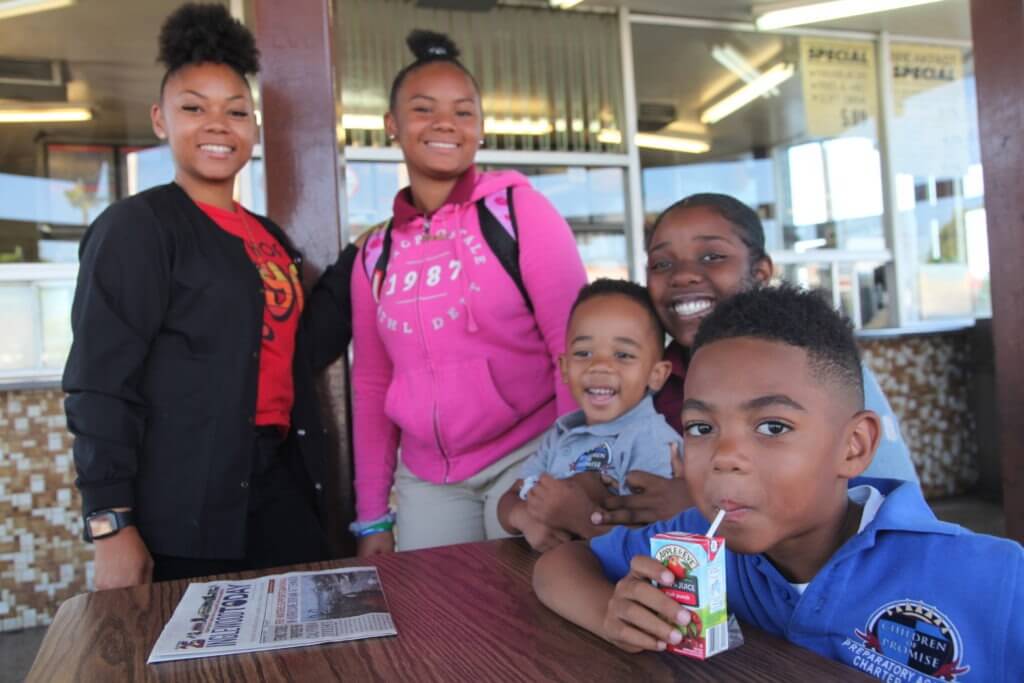Generation after generation come together over burgers and fries at the classic Crenshaw joint.
The first big change in my Inglewood neighborhood happened when I was 13. A drive-thru Starbucks was built in the strip mall on W. 120th St. and Crenshaw Boulevard, right next to the 105 East Freeway on-ramp. My mom and I would walk nearly a mile to the Starbucks for exercise on the weekends. She would bring her Taser to fend off stray dogs and I would speed-walk over the Van Ness Avenue overpass, afraid of the whooshing of the speeding cars.
We didn’t know it at the time, but that Starbucks was a harbinger of change, not just to that stretch of my neighborhood, but for Inglewood as a whole. The historic city with a majority Latino population and African-American roots is changing at hyper-speed. My stretch of street is a kind of case study for Inglewood’s future as a new football stadium, an arena for the Clippers, and a halo of attendant businesses will be arriving in the area. As longtime African American residents of the neighborhood have been replaced by young new families, the Starbucks parking lot is often filled with Toyotas and Teslas belonging to SpaceX tech dudes, chatting over morning coffee or during their lunch breaks.
But nearby this changing stretch of Crenshaw, there’s a landmark of my childhood: Brolly Hut.

The umbrella-themed restaurant is one of the oldest in Inglewood. Founded in 1970, Brolly Hut has served fast-food breakfast, lunch and dinner in the same location for 49 years, as other restaurants have come and gone around them. They’re best known for their pastrami, but if you ask me they have the best fries in L.A. And the best part about the old-school burger stand is that it has stayed exactly the same for decades: an octagon of floor-to-ceiling windows with an umbrella roof and a sign holding onto a blown-out umbrella to match. Built amid the era of themed buildings in LA, the adherence to the umbrella theme seems to show the dedication to wait out the storm of restaurants that come and go.
I’ve eaten Brolly Hut my whole life. At least once a month my dad would call and make his order over the phone, and then we would drive the few blocks and go pick up my fries and his pastrami. For my dad, this wasn’t a new routine, but one adapted to include me. He’d been getting Brolly Hut since 1974 when he moved to Inglewood at 13. The restaurant had been a mainstay, a treat and a port in the storm for two generations. Now with Inglewood changing all around me, it’s the only identifying landmark I have left in my childhood neighborhood.

Even though it’s such an important part of my upbringing, Brolly Hut isn’t widely known. It’s a very Inglewood-specific burger joint. The place that gets mentioned by a hometown legend every once in a while in an article, or featured on a list like Nikki Kreuzer’s Offbeat L.A., a master list of L.A.’s oldest restaurants. It seems few people know this neighborhood landmark unless you grew up with it. It’s a very old school Inglewood joint.
An unsung landmark
Identifying landmarks can be varied when your hometown is as big as Los Angeles, especially when exploring the urban sprawl. Many famous — and not so famous — landmarks are scattered across the city, requiring a pretty long drive. It’s almost a requirement for any “authentic L.A.” outing: Sunday morning movies at the Cinerama Dome; shopping trips to the Apple Store and the four-story Barnes and Noble at the Grove, ending with homemade fudge at the Farmer’s Market; bean and cheese burritos at Tito’s Tacos.
Yet for South L.A-raised people like me, these landmarks are even farther: at least 10 miles away from our home near Crenshaw. Landmarks south of the 10 Freeway — like Brolly Hut — are largely ignored on both the West and Eastside. Our cultural landmarks, it seems, only enter into the consciousness when the people who live there make a big enough contribution to the cultural zeitgeist to be noticed by the mostly white gatekeepers who traditionally have written L.A histories and neighborhood spotlights. For Hawthorne, it was the Beach Boys, or Space X today. For Compton, it was N.W.A. For Hyde Park, it was Nipsey Hussle. For Inglewood it was the Lakers at the Forum, until Issa Rae’s “Insecure” brought it back into the foreground, showcasing the neighborhood to a wider audience.

Brolly Hut isn’t likely to be noticed or trending, but it’s not for lack of history or steady business. It’s because the gatekeepers don’t frequent the area. They don’t know about the neighborhood loyalty or the best fries in L.A. And without any interference from those that don’t understand the vibe or the community, neighborhood landmarks like Brolly Hut can flourish, unchanged and unwavering.
After 49 years of service, Brolly Hut’s legacy is held by the patrons — like my dad and I — who have been buying pastrami and fries for generations. These are the typical residents of Inglewood, working-class black and Latino men and women. The busiest rushes at Brolly Hut revolve around work schedules, lunch breaks, weekend mornings; on Sundays entire families sit down to eat breakfast under the umbrella fixtures hanging from the ceiling. It’s the type of restaurant where becoming a regular is easy.
I’m grateful to Brolly Hut for sticking around. The restaurant has been steady through a lot— through major earthquakes and the L.A. Riots. I can’t imagine what life was like in 1970, but in 2019, everything seems to be in either a state of flux or on the verge of being destroyed. When I feel overwhelmed by the state of the world, it’s nice to drive down Crenshaw to a place that’s always been there, a port in the storm. Especially when the world is on fire, I’m grateful to Brolly Hut for staying the same.

